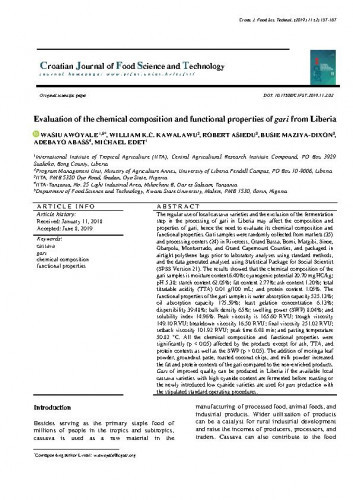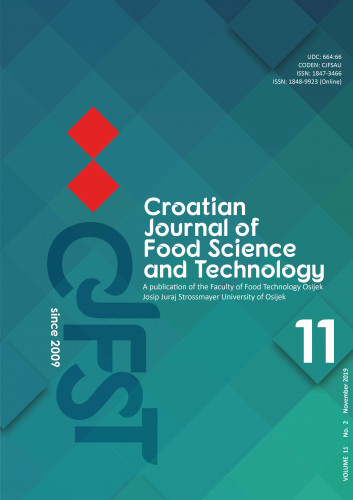The regular use of local cassava varieties and the exclusion of the fermentation step in the processing of gari in Liberia may affect the composition and properties of gari, hence the need to evaluate its chemical composition and functional properties. Gari samples were randomly collected from markets (35) and processing centers (24) in Rivercess, Grand Bassa, Bomi, Margibi, Sinoe, Gbarpolu, Montserrado, and Grand Capemount Counties, and packaged in airtight polythene bags prior to laboratory analyses using standard methods, and the data generated analysed using Statistical Package for Social Scientist (SPSS Version 21). The results showed that the chemical composition of the gari samples is moisture content 6.40%; cyanogenic potential 20.70 mg HC/kg; pH 5.38; starch content 62.05%; fat content 2.77%; ash content 1.20%; total titratable acidity (TTA) 0.01 g/100 mL; and protein content 1.05%. The functional properties of the gari samples is water absorption capacity 525.13%; oil absorption capacity 175.59%; least gelation concentration 6.13%; dispersibility 39.48%; bulk density 65%; swelling power (SWP) 8.04%; and solubility index 14.96%. Peak viscosity is 165.60 RVU; trough viscosity 149.10 RVU; breakdown viscosity 16.50 RVU; final viscosity 251.02 RVU; setback viscosity 101.92 RVU; peak time 6.48 min; and pasting temperature 50.82 °C. All the chemical composition and functional properties were significantly (p <0.05) affected by the products except for ash, TTA, and protein contents as well as the SWP (p >0.05). The addition of moringa leaf powder, groundnut paste, roasted coconut chips, and milk powder increased the fat and protein contents of the gari compared to the non-enriched products.
Sažetak

 Croatian journal of food science and technology : a publication of the Faculty of Food Technology Osijek : 11,2(2019) / editor-in-chief Jurislav Babić.
Croatian journal of food science and technology : a publication of the Faculty of Food Technology Osijek : 11,2(2019) / editor-in-chief Jurislav Babić.